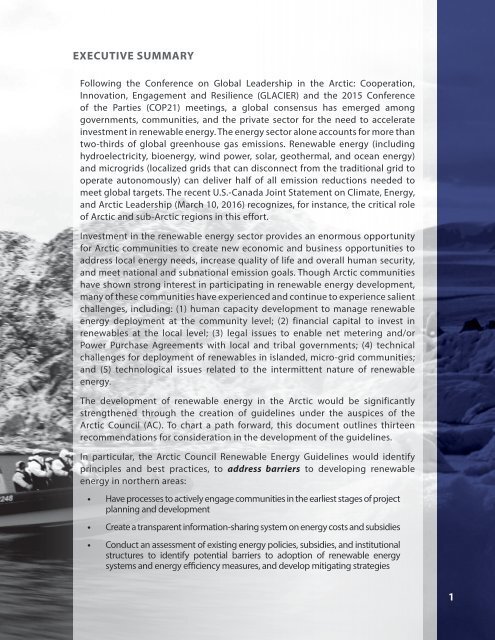DEVELOPING RENEWABLE ENERGY IN ARCTIC AND SUB-ARCTIC REGIONS AND COMMUNITIES
FulbrightArcRenewableEnergy
FulbrightArcRenewableEnergy
You also want an ePaper? Increase the reach of your titles
YUMPU automatically turns print PDFs into web optimized ePapers that Google loves.
EXECUTIVE SUMMARY<br />
Following the Conference on Global Leadership in the Arctic: Cooperation,<br />
Innovation, Engagement and Resilience (GLACIER) and the 2015 Conference<br />
of the Parties (COP21) meetings, a global consensus has emerged among<br />
governments, communities, and the private sector for the need to accelerate<br />
investment in renewable energy. The energy sector alone accounts for more than<br />
two-thirds of global greenhouse gas emissions. Renewable energy (including<br />
hydroelectricity, bioenergy, wind power, solar, geothermal, and ocean energy)<br />
and microgrids (localized grids that can disconnect from the traditional grid to<br />
operate autonomously) can deliver half of all emission reductions needed to<br />
meet global targets. The recent U.S.-Canada Joint Statement on Climate, Energy,<br />
and Arctic Leadership (March 10, 2016) recognizes, for instance, the critical role<br />
of Arctic and sub-Arctic regions in this effort.<br />
Investment in the renewable energy sector provides an enormous opportunity<br />
for Arctic communities to create new economic and business opportunities to<br />
address local energy needs, increase quality of life and overall human security,<br />
and meet national and subnational emission goals. Though Arctic communities<br />
have shown strong interest in participating in renewable energy development,<br />
many of these communities have experienced and continue to experience salient<br />
challenges, including: (1) human capacity development to manage renewable<br />
energy deployment at the community level; (2) financial capital to invest in<br />
renewables at the local level; (3) legal issues to enable net metering and/or<br />
Power Purchase Agreements with local and tribal governments; (4) technical<br />
challenges for deployment of renewables in islanded, micro-grid communities;<br />
and (5) technological issues related to the intermittent nature of renewable<br />
energy.<br />
The development of renewable energy in the Arctic would be significantly<br />
strengthened through the creation of guidelines under the auspices of the<br />
Arctic Council (AC). To chart a path forward, this document outlines thirteen<br />
recommendations for consideration in the development of the guidelines.<br />
In particular, the Arctic Council Renewable Energy Guidelines would identify<br />
principles and best practices, to address barriers to developing renewable<br />
energy in northern areas:<br />
• Have processes to actively engage communities in the earliest stages of project<br />
planning and development<br />
• Create a transparent information-sharing system on energy costs and subsidies<br />
• Conduct an assessment of existing energy policies, subsidies, and institutional<br />
structures to identify potential barriers to adoption of renewable energy<br />
systems and energy efficiency measures, and develop mitigating strategies<br />
1


